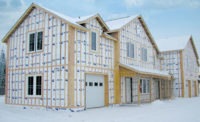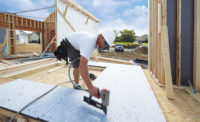Insulation Tips for Building Envelope

Don’t forget below-grade walls and floor slabs.

Don’t forget below-grade walls and floor slabs.

Don’t forget below-grade walls and floor slabs.

Don’t forget below-grade walls and floor slabs.




Virtually no architect or contractor would design or construct a building without insulation in the walls or roof. Savvy building professionals also insulate below-grade, including buried foundation walls and under floor slabs. However, how important is insulation in those areas?
The EPS Industry Alliance notes that a lack of insulation on below-grade foundations, crawlspaces and under-slabs accounts for up to 25 percent of a building’s total energy loss. The Green Building Advisor website explains, “If you live in Climate Zone 3 or anywhere colder, it’s cost-effective and wise to install basement wall insulation”—in other words, insulation below grade and under slab makes sense in most of the U.S.
Un-insulated concrete provides a thermal bridge between a building’s heated interior and the relatively cooler earth surrounding the building, or through exposed slab edges to the outside air. Therefore, blocking that heat flow is critical for creating a comfortable, energy-efficient building. Additionally, below-grade insulation helps manage moisture to reduce interior condensation on foundation walls. When installed on the exterior, rigid insulation helps prevent freeze-thaw cycling damage.
When choosing among rigid foam insulations for below-grade applications, be sure to evaluate moisture resistance, along with thermal performance (R-value). For the most cost-effective under-slab installations, it is also crucial to consider compressive resistance.
Moisture Resistance
Damp insulation is far less effective at blocking the flow of heat than dry insulation is. The thermal values of damp insulation can also degrade over time. Therefore, it is important when choosing any insulation to consider its moisture performance. This is especially true in below-grade applications, as insulation there is frequently exposed to elevated moisture from damp soil—especially in areas with any amount of rainfall.
Among the rigid foam insulations, EPS, GPS and XPS are commonly used below-grade, while polyisocyanurate “should not be used because it can absorb water,” says a green building advisor. EPS and GPS perform significantly different from XPS in terms of moisture and much confusion exists about which one is better. Ultimately, it depends on how you measure it.
Manufacturers of products typically agree that EPS and GPS absorb small amounts of moisture more quickly than XPS does. This would seem to imply that XPS offers superior moisture performance. It is crucial to understand that EPS also releases moisture much faster than XPS does. This is crucial when considering how both materials perform in the field compared to in the lab.
Most buildings are not constructed below the water table; consequently, the soil surrounding the foundation goes through periods of wetting and drying. XPS tends to hold onto moisture longer through this cycling, while EPS releases it and returns to high thermal resistance. This is borne out by
extensive real-world testing.
For example, the independent lab, Stork Twin City Testing, evaluated the moisture content of EPS and XPS buried side-by-side for 15 years on a laboratory’s foundation in St. Paul, Minnesota. At the time the insulations were removed, the EPS was four times drier than the XPS—the EPS had only 4.8 percent moisture by volume compared to 18.9 percent moisture content for the XPS. After 30 days of drying time, the EPS had dried to only 0.7 percent moisture by volume, while the XPS still contained 15.7 percent moisture.
Thermal Performance (R-value)
As discussed above, moisture is the enemy of insulation when it comes to thermal performance. The Stork Twin City Testing Laboratory 15-year in-situ evaluation that was previously discussed, found that EPS retained 94 percent of its specified R-value, whereas the XPS only retained 52 percent of its R-value when wetted.
In addition to drying quickly and having minimal long-term moisture retention, EPS and GPS products do not experience “thermal drift.” This means that EPS or GPS insulation retains its published R-value during its time in service. This is because neither rigid insulation type is made with blowing agents that diffuse over time.
Compressive Resistance
Concrete floor slabs weigh a great deal; subsequently it seems logical that insulation installed below them should have a high compressive resistance. Although it is important for thermal performance that below-slab insulation is not to be deformed by the slab’s weight, too often this insulation is over-engineered. This results in excessive costs and materials. Installing an insulation with higher-than-needed compressive resistances does not offer any significant performance advantages and wastes money.
The problem is that a common engineering assumption overstates how much load is transferred through the slab to the insulation. Instead of transferring in a trapezoidal fashion as typically calculated, research shows that concrete slabs distribute loads more evenly. As a result, a lower compressive resistance is often needed for an insulation, which can dramatically reduce material costs.
To avoid an unnecessary hit to your bottom line from over-engineered insulation, confirm if the project engineer used calculations based on the Theory of Plates on Elastic Foundations. The formula in this theory takes into account how slabs and insulation behave together.
Conclusion
Below-grade foundations and floor slabs are as much a part of the building envelope as walls and roofs are. As such, below-grade parts of the building should be insulated to provide a comfortable and energy-efficient building. Forgoing insulation in these areas can cost your building owner clients big, as missing below-grade insulation accounts for up to 25 percent of a building’s total energy loss.
Looking for a reprint of this article?
From high-res PDFs to custom plaques, order your copy today!






.png?height=200&t=1741113368&width=200)






